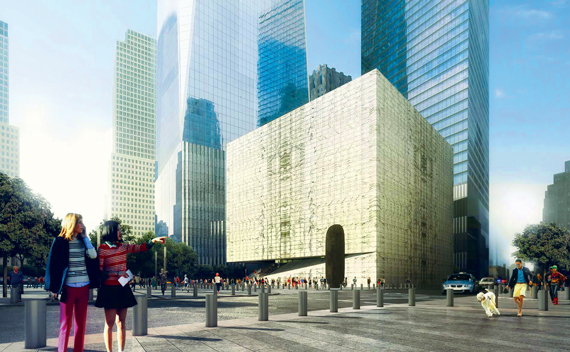Trending
A bravura performance
The WTC’s arts center design </br>deserves a standing ovation

In a city where so much of the new architecture is indifferent, the World Trade Center site stands out for the exceptional quality and execution of its designs. The area is evolving into one of the most successful and beautiful nurseries of new architecture in the city, and the newest project planned for its campus, the Ronald O. Perelman Performing Arts Center, promises to be a valuable addition. The design, by Joshua Prince-Ramus, ably rises to the very high standard set by such structures as Santiago de Calatrava’s World Trade Center Transportation Hub and Fumihiko Maki’s Tower Four.
Renderings of the performing arts center, released in September, show a perfect cube clad in rose-hued marble, which is to become an integral part of the fast-developing World Trade Center campus. Its ultimate success, of course, will depend on its execution, but there is much to be optimistic about, including the revival of the long-stalled $250 million project itself, which was reinvigorated by a $75 million gift from Perelman this summer.
A cultural center was always to be part of the World Trade Center redevelopment, having been included in Daniel Libeskind’s 2003 master plan. But like so much else at Ground Zero, its path was neither swift nor straight, beset by funding difficulties, a number of potential anchor institutions pulling back, and the decision to scrap Frank Gehry’s design of cascading rectangles and tree plantings.

Joshua Prince-Ramus
Still, if you compare the evolution of the World Trade Center site with Lincoln Center, Hudson Yards or Trump World Plaza, it has all been rather swift, considering the size and complexity of the project. Impressively, not a single one of the buildings or monuments that has been completed has failed to rise above the usual standards of New York City architecture. Some of these structures, such as the Transit Hub, Tower Four, and Michael Arad’s memorial pools, rise far above that standard. Not only are these and all the other parts of the site well designed, but they are also well made, which is hardly a foregone conclusion in the Big Apple. Nor is a complex whose buildings work both individually and collectively. Consider Lincoln Center, which though delightful on the whole, is composed of structures that are mediocre or worse.
The Perelman Performing Arts Center is set to rise at the northern edge of the World Trade Center site, nestled between Tower One and Tower Two, with the Northern Pool and Transit Hub to its immediate south. Its form promises to be instantaneously legible: the rose-colored marble cube that seems to gleam into gold in some light. In the evening, according to Prince-Ramus himself, it will bring to mind a jack-o’-lantern, as the bright light from within transpierces the marble’s surface. The only distortion of its cubic integrity and disruption of its otherworldly serenity is an angled gash at its base, with stairs that serve as an entrance and recall the rhythms of the architect’s design for the Seattle Public Library.
The center will contain 99,000 square feet given over to three auditoriums on the three different levels. Due to the necessity for enhanced flexibility, as the center will focus primarily on new works, these spaces will feature movable walls that can be arranged in 11 distinct configurations. The largest of these will be able to accommodate 1,200 people for events like rock concerts. The center will also be the new home of the Tribeca Film Festival.
The building, which is scheduled to be completed in early 2020, is the architect’s first ground-up structure in Manhattan. Prince-Ramus, the principal of REX, was the founding partner of OMA New York, the American wing of the much-discussed Office for Metropolitan Architecture/Rem Koolhaas, which morphed into REX in 2006.
On the basis of Prince-Ramus’ designs for the Guggenheim-Hermitage Museum in Las Vegas and the Seattle Central Library, there is good reason to have high hopes about his latest project. The 10-year-old Seattle Public Library exhibits all the slashing angles and irregular masses he learned during his apprenticeship with Koolhaas. In time, however, Prince-Ramus has shifted away from that truculent irregularity in the direction of an almost metaphysical quest for order and tranquility. His Necklace Residence, a country home on Long Island, uses mirrored curtain walls on a series of houses to infinitely replicate and reflect the surrounding forest. Meanwhile, his 2050 M Street design in Washington, D.C., with its sheer glass facade — a sequence of fluted indentations inflecting its pristine surface — could be one of the most stunning and original architectural acts of the new millennium if it is completed in a way that lives up to the renderings.
Also encouraging is the fact that, to date, some of Prince-Ramus’ most conspicuous successes have come in the form of performing arts centers, especially his Dee and Charles Wyly Theatre at the AT&T Performing Arts Center in Dallas, which is in many ways similar to his design for the Perelman Performing Arts Center. Like the Perelman, the AT&T Center, which opened in 2009, reads as a nearly perfect, monolithic cube, with an irregularly placed opening. It owes its richly textured surface to extruded anodized aluminum, while the New York building promises translucent stretches of golden marble.
In both cases, Prince-Ramos exemplifies a trend that is increasingly prevalent in contemporary architecture: the emphatic insistence on surface to the rejection of structure, suggesting an almost artificial insubstantiality. This trend, often associated with the architecture of Steven Holl and Herzog & de Meuron, can be seen in Holl’s design for Columbia University’s Campbell Sports Center in Upper Manhattan, which is also rather energetically volumetric. It’s also evident in the ground floor of Herzog & de Meuron’s 40 Bond Street, a far more sedate building.
Interior renderings of the Perelman building are far less revealing, though the adjustable nature of the performance spaces suggests the partial rejection of architecture writ large, in the service of functionality. As for the entranceway, it reflects a mod aesthetic favored by Koolhaas, invoking such modernist icons as Louis Kahn’s Yale University Art Gallery.
Like so many of the architectural events that have arisen or are scheduled to rise at the World Trade Center site, the Perelman Performing Arts Center looks nothing like the others. It has its own identity, its own language and its own center of gravity. But the daring of its design, combined with that of the other designs at the WTC, suggests that they will all play well together, and that the result will be far better than anything we could have hoped for a decade ago.




